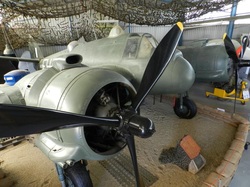DEPARTMENT OF AIRCRAFT PRODUCTION
DAP Mk 21 Beaufighter
 Click on image for larger version
Click on image for larger version
The Bristol Beaufighter was designed in the late 1930s utilising many of the features and components of the Bristol Beaufort bomber and built in Britain and later in Australia. The RAAF Beaufighters were a two seat, multi role and heavily armed long range aircraft and powered by two 1,735hp Bristol Hercules engines. In total 5,928 aircraft of the type were produced of which 364 were produced in Australia under license by the Department of Aircraft Production (DAP) as Mk21 between September1944 and the end of hostilities in1945.
The type initially saw service as a night fighter in Britain. The RAAF operated 583 Beaufighters, of which 200 odd were delivered from Britain. Seven Squadrons were raised of which Nos 454 and 459, served in Europe for the duration, and the other five Nos 22,30,31, 92 and 93 moved into the Pacific theatre of operations.
The RAAF Beaufighters were used in a ground attack role in the New Guinea campaign, where their heavy armament of 4x20 mm canon and 4x50calibre machine guns plus other assorted ordnance, including torpedoes and air to ground rocket projectiles, coupled with their low altitude speed capabilities and low noise level, exacted a heavy toll on the enemy, and the thought is that the term "Whispering Death" emanated from those operations. RAAF Beaufighters were also used extensively in an anti-shipping role inflicting severe naval loses upon enemy forces, particularly with the involvement of No 30 Squadron RAAF in the Battle of the Bismark Sea in early March 1943.
The build of the Museum's Beaufighter A8-328 was completed on the last day of WW2 then stored at Tocumwal New South Wales until November 1950 when it was fitted out for target towing. It served with No 30 Target Towing Squadron until being issued to the Melbourne Lord Mayer's children's camp at Portsea on December 14, 1956. In 1962 it became the first aircraft to be donated to the Museum, and entered a 10 year restoration program, and is now on display dressed up as an aircraft from No 31 Squadron with unit ID of EH-K.
The A8-328 is one of only two Australian built units in existence. Two others are complete in Britain and one in the USA. two more are under restoration, one in Canada and one in Britain.
TECHNICAL DATA
Power plant : 2x 1,735hp Bristol Hercules XV11 14 cylinder sleeve valve radial engines
Length : 44' 08'' (12.70m) Wingspan : 57'10'' (17.63m) Height : 15'09'' (4.82m)
Weights : empty - 15,600lbs (7.076kg) maximum - 25,150lbs (11,521kg)
Speeds : maximum - 270kt (325mph) (520km/hr) at 10,000' (3,000m)
Range : 1,470 miles (2,365km)
The type initially saw service as a night fighter in Britain. The RAAF operated 583 Beaufighters, of which 200 odd were delivered from Britain. Seven Squadrons were raised of which Nos 454 and 459, served in Europe for the duration, and the other five Nos 22,30,31, 92 and 93 moved into the Pacific theatre of operations.
The RAAF Beaufighters were used in a ground attack role in the New Guinea campaign, where their heavy armament of 4x20 mm canon and 4x50calibre machine guns plus other assorted ordnance, including torpedoes and air to ground rocket projectiles, coupled with their low altitude speed capabilities and low noise level, exacted a heavy toll on the enemy, and the thought is that the term "Whispering Death" emanated from those operations. RAAF Beaufighters were also used extensively in an anti-shipping role inflicting severe naval loses upon enemy forces, particularly with the involvement of No 30 Squadron RAAF in the Battle of the Bismark Sea in early March 1943.
The build of the Museum's Beaufighter A8-328 was completed on the last day of WW2 then stored at Tocumwal New South Wales until November 1950 when it was fitted out for target towing. It served with No 30 Target Towing Squadron until being issued to the Melbourne Lord Mayer's children's camp at Portsea on December 14, 1956. In 1962 it became the first aircraft to be donated to the Museum, and entered a 10 year restoration program, and is now on display dressed up as an aircraft from No 31 Squadron with unit ID of EH-K.
The A8-328 is one of only two Australian built units in existence. Two others are complete in Britain and one in the USA. two more are under restoration, one in Canada and one in Britain.
TECHNICAL DATA
Power plant : 2x 1,735hp Bristol Hercules XV11 14 cylinder sleeve valve radial engines
Length : 44' 08'' (12.70m) Wingspan : 57'10'' (17.63m) Height : 15'09'' (4.82m)
Weights : empty - 15,600lbs (7.076kg) maximum - 25,150lbs (11,521kg)
Speeds : maximum - 270kt (325mph) (520km/hr) at 10,000' (3,000m)
Range : 1,470 miles (2,365km)
